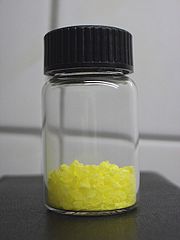User:Praseodymium-141/Sandbox4
Halides and their derivatives
[edit]Twelve binary halides, compounds with the formula VXn (n=2..5), are known. VI4, VCl5, VBr5, and VI5 do not exist or are extremely unstable. In combination with other reagents, VCl4 is used as a catalyst for polymerization of dienes. Like all binary halides, those of vanadium are Lewis acidic, especially those of V(IV) and V(V). Many of the halides form octahedral complexes with the formula VXnL6−n (X= halide; L= other ligand).
Many vanadium oxyhalides (formula VOmXn) are known.[1] The oxytrichloride and oxytrifluoride (VOCl3 and VOF3) are the most widely studied. Akin to POCl3, they are volatile, adopt tetrahedral structures in the gas phase, and are Lewis acidic.


Niobium forms halides in the oxidation states of +5 and +4 as well as diverse substoichiometric compounds.[2][3] The pentahalides (NbX
5) feature octahedral Nb centres. Niobium pentafluoride (NbF5) is a white solid with a melting point of 79.0 °C and niobium pentachloride (NbCl5) is yellow (see image at left) with a melting point of 203.4 °C. Both are hydrolyzed to give oxides and oxyhalides, such as NbOCl3. The pentachloride is a versatile reagent used to generate the organometallic compounds, such as niobocene dichloride ((C
5H
5)
2NbCl
2).[4] The tetrahalides (NbX
4) are dark-coloured polymers with Nb-Nb bonds; for example, the black hygroscopic niobium tetrafluoride (NbF4) and brown niobium tetrachloride (NbCl4).
Anionic halide compounds of niobium are well known, owing in part to the Lewis acidity of the pentahalides. The most important is [NbF7]2−, an intermediate in the separation of Nb and Ta from the ores.[5] This heptafluoride tends to form the oxopentafluoride more readily than does the tantalum compound. Other halide complexes include octahedral [NbCl6]−:
- Nb2Cl10 + 2 Cl− → 2 [NbCl6]−
As with other metals with low atomic numbers, a variety of reduced halide cluster ions is known, the prime example being [Nb6Cl18]4−.[6]
Tantalum halides span the oxidation states of +5, +4, and +3. Tantalum pentafluoride (TaF5) is a white solid with a melting point of 97.0 °C. The anion [TaF7]2- is used for its separation from niobium.[5] The chloride TaCl
5, which exists as a dimer, is the main reagent in synthesis of new Ta compounds. It hydrolyzes readily to an oxychloride. The lower halides TaX
4 and TaX
3, feature Ta-Ta bonds.[2][3]
- ^ Greenwood, Norman N.; Earnshaw, Alan (1997). Chemistry of the Elements (2nd ed.). Butterworth-Heinemann. p. 993. ISBN 978-0-08-037941-8.
- ^ a b Cite error: The named reference
HollemanAFwas invoked but never defined (see the help page). - ^ a b Agulyansky, Anatoly (2004). The Chemistry of Tantalum and Niobium Fluoride Compounds. Elsevier. pp. 1–11. ISBN 978-0-444-51604-6. Cite error: The named reference "Aguly" was defined multiple times with different content (see the help page).
- ^ Lucas, C. R.; Labinger, J. A.; Schwartz, J. (1990). Robert J. Angelici (ed.). Dichlorobis(η5-Cyclopentadienyl)Niobium(IV). Inorganic Syntheses. Vol. 28. New York. pp. 267–270. doi:10.1002/9780470132593.ch68. ISBN 978-0-471-52619-3.
{{cite book}}: CS1 maint: location missing publisher (link) - ^ a b Soisson, Donald J.; McLafferty, J. J.; Pierret, James A. (1961). "Staff-Industry Collaborative Report: Tantalum and Niobium". Industrial and Engineering Chemistry. 53 (11): 861–868. doi:10.1021/ie50623a016. Cite error: The named reference "ICE" was defined multiple times with different content (see the help page).
- ^ Greenwood, Norman N.; Earnshaw, Alan (1997). Chemistry of the Elements (2nd ed.). Butterworth-Heinemann. ISBN 978-0-08-037941-8.
